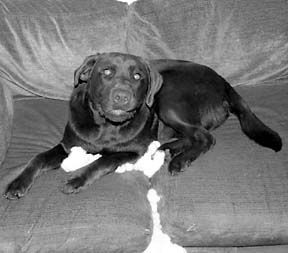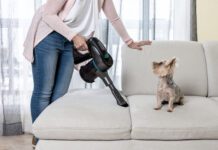We love our Labrador Retriever, Bailey, very much. We rescued her when she was six weeks old. She is now almost two years old.
We believe that a dog is part of the family and therefore should live inside the house with the rest of the family. However, we were warned about Labs and their desire to chew and need for a lot of exercise. We were prepared for the worst. We limited Bailey’s living quarters to the kitchen and family room. There is a dog door in the kitchen that allows her to go outside whenever she pleases. We restricted her to this area for the first year of her life. We now find that when we take the barriers down, she prefers to stay in that area.
Bailey went through the normal teething stage that most puppies go through. We lost a couple of chairs and a cabinet. However, we were prepared and knew that it was one of the downfalls of having such an adorable puppy. But she is no longer a puppy.
We provide Bailey with a lot of love and attention – maybe too much! My husband works nights and I work days so that Bailey has someone with her most of the time. However, there are occasions when we both need to be gone for an entire day. We try our best to leave her plenty of toys and rawhide bones (her favorite). We find that when we are gone, Bailey will not play with her toys or eat her bones. She will wait until we return and then she plays and chews on her bone. And if we leave her alone for more than six hours, say, she chews on the couch.
This horrible habit started about a year ago. I have tried everything to stop her. She actually likes the taste of that bitter apple repellent. It is difficult to cover the entire couch with pepper spray. We thought that this was another habit she would outgrow, but she hasn’t. She no longer chews on the other furniture or the carpet, so I don’t think it is just a chewing fetish. Bailey is a very smart dog, and initially, I thought it was revenge for leaving her for so long. Then I thought she was trying to send up a message: “Don’t leave me again!”
Most trainers suggest using toys, but she has a whole collection and that doesn’t work. Some trainers have suggested locking her outside when we are not home. I would hate to lock her out in the rain or excessive heat. The problem is that Bailey doesn’t do this bad behavior when we are home so there is no way to correct her.
Do you have any suggestions?
-Lisa Duran
San Jose, CA
We directed this question to Dr. Ian Dunbar, a veterinarian and dog trainer residing in Berkeley, CA. A native of England, Dr. Dunbar is the founder of the Association of Pet Dog Trainers, the creator of the K9 Games, and is well-known for his renowned Sirius Puppy Training program, which he describes in his popular books and instructional videos.
First, let me commend you on what is obviously a caring relationship you share with your dog. I thoroughly agree with you that locking a dog out of a house because he or she is destroying the inside is NOT a logical solution to the problem. Taking that approach might have saved your couch, but would have only put your landscaping and fence at risk, not to mention your relationship with your neighbors. When a dog has a problem with the absence of his or her owner, “throwing the dog out” will only promote further misbehavior, usually including barking, howling, and digging.
And lest you feel alone, let me assure you that this is both a common problem and a simple one to solve. Golden Retrievers and Labradors are two of the most common breeds, and, as social, active dogs, they very commonly find this kind of trouble to get into. In fact, many Labs, especially field dogs, are so active, they actually manifest what borders on an obsessive/compulsive disorder. I don’t want to upset you or other Lab people here; this can actually be a good thing, because it is so easy to channel the dog’s restlessness into good behavior. A dog who wants to do stuff is easy to direct.
The answer is to get the dog focused on chew toys to the point where she is virtually a “chew toyaholic.” You are going to use her obsessions and compulsions and simply redirect them from worrying about your absence and dismantling the couch, to chewing on a chew toy, specifically at times when you are absent.
But wait! You said the dog has a lot of chew toys, but that she won’t play with them while you are gone. Right. Then you need to get rid of the dog’s food bowl. What? Hang on, I’m still making sense:
If the dog is fed out of a food bowl, you are actually giving away a couple hundred rewards a day for free. From now on, feed this dog only in chew toys. Go out and buy about six long bones and six Kongs, and stuff all the dog’s food into them.
Here’s how I do it. You want the toys filled in such a manner that the instant the dog touches it, a bit of food falls out, and if she touches it again, a little more falls out, and so on. But always, no matter what she does, the tastiest bits remain stuck in there. So you get a bit of cheese or freeze dried liver and stick it into the little hole in the end of the Kong. Your dog will never be able to get that out! Then you smear a bit of honey or peanut butter on the inside of the Kong, and fill it with the dog’s normal kibble. This make the food tastier, and ensure that it won’t all tumble out at once.
Another way to do this is to measure out the dog’s kibble, add water, and mix it into a mush. Then you stuff the mush into some Kongs and then put them into the freezer for the night; you make Kongsicles! A Canadian breed like the Lab ought to appreciate that! They take about two hours to thaw and for the dog to get all her food. (If you think about it, this is how dogs eat in the wild. They do not get fed a big bowl of food at 5 p.m. every day. They have to work and gnaw on a carcass to get their meals.)
OK, so you are going to feed only in Kongs from now on, but you are going to do it in a way that teaches the dog to associate this treat with your absence. So this is your daily ritual: Let your dog watch you stuff the Kongs with food, but don’t give them to her. When you leave the house, put her in the long-term confinement area (going back to keeping her in your kitchen is an excellent idea) and give her all the food-stuffed toys.
Some dogs don’t like eating alone, but as long as you are not feeding Bailey any other way, I guarantee she’ll start looking forward to spending time getting her food out of the Kongs within a few days, a week at the most.
I help my dogs anticipate the event by making a big fuss about the preparation. I show them what I’m doing, and tell them what I’m doing as I stuff the Kongs. I say, “Oh, why don’t we put a bit of cheese in this one? And look, here’s some peanut butter mixed with freeze dried liver . . . Yum!” Then I put the toys on the floor of the kitchen and shut the door. “Sorry, not yet! I’m not ready to go yet!” People who use crates can put the Kongs in a crate and then lock the dog out of it. Then, when you’re ready to leave, open the door to the kitchen or crate; the dog will not miss you, believe me, in her rush to get to the toys.
You may or may not have noticed that I said this should be your daily routine. This procedure works great for people who go to work every day and leave the dog home alone all day. But the schedule you described (your husband works nights and you work days) doesn’t always leave room for the dog to be alone with the toys. So you need to make time for the dog to be alone, even when someone is home.
On one hand, it’s great that some people have households where the dog can usually be close to someone. Dogs are social animals, and they love company. But this kind of routine can actually create an owner-absent problem; it makes the dog over-dependent on having human company.
It is a sad fact of modern-day life, but most dogs can’t be with us all the time. So, rather than letting her stress out and fall apart every time she is left all alone, you need to train her to expect and enjoy being left alone on a daily basis. This way, she will be prepared for the experience; it’s no big deal. And the food-filled toys will ensure she will begin to look forward to her time alone.
So, rather than having the dog in the room you are in every minute, create some “down time” for her. When you are at home, and you have some time, say, when your favorite TV show comes on, put her in the kitchen with her evening meal all packed into the Kong toys. You can go watch Ally McBeal upstairs, but leave the dog in the kitchen.
I actually regard this as the most important thing, the number one thing, to teach a puppy: to enjoy spending time alone at home. If you don’t do this, your dog will stress out and will fall apart every time she is left alone, at which point her obsessions and compulsions will become directed to dismantling the house – and the dog may end up getting thrown out of the household altogether.
Good luck with Bailey, and have some fun with this!
Long-Term Vitamin C?
I have a female German Shepherd who is just shy of two years old. After reading your article about vitamin C (“Oh Say, Can You ‘C’?”, WDJ September 1998), I started giving her vitamin C to treat an allergy-type skin condition (scratching, redness). I ran the idea past my veterinarian first and got his blessing. But while this has helped with the scratching and redness, and I have been able to discontinue her vet-prescribed allergy pills, I am a little concerned about the dosage that I am giving her.
I am using pure sodium ascorbate powder (WDJ’s #1 recommendation) and have increased her dosage up to 4000 mg. twice a day. This has been a gradual increase until we started seeing results. While I have seen no negatives from this dosage (the redness has decreased, scratching subsided, and it has had no effect on her stool, which is still solid and formed), the dosage seems high. I’m just looking for a little reassurance that I am not in any way harming my dog.
-Cheryl J. Elksnis
Baltimore, MD
We submitted this question to the pioneer of vitamin C therapy in canines, Dr. Wendell O. Belfield, of San Jose, California. In 1981, Dr. Belfield has published the most complete work on vitamin C therapy for dog owners, “How to Have a Healthier Dog,” which was revised and reissued in 1993). He also authored the chapter about orthomolecular therapy in the 1998 veterinary textbook, “Complementary and Alternative Veterinary Medicine.”
I’m not surprised that you saw positive results from supplementing your dog with vitamin C. You used the form of the vitamin that is most beneficial for dogs (sodium ascorbate) and correctly increased the dose, using the dog’s bowel tolerance as a guide. However, now that the dog’s skin has improved, I would suggest that you begin reducing the dosage.
The dosage you are using is not likely to cause harm, but no vitamin should be used at levels higher than a maintenance dose for long periods. Do what you have to do to resolve a health problem, and then reduce the dosage to a maintenance level.
For small dogs and cats, I suggest a maintenance dose of 750 mg of sodium ascorbate; for medium dogs (25 to 50 pounds), I would use 1500 mg; and for large dogs (50 to 100 pounds and up), I would use 3000 mg.
If your dog’s skin problems recur, you may wish to increase the dosage again. However, if this happens, I would suggest doing some detective work to identify and eliminate the source of the dog’s allergies.






